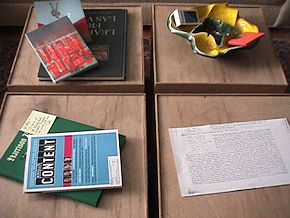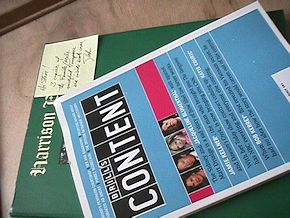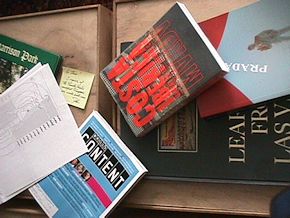"Exactly this equivalence of form and content is negated in the Campo Marzio. The only "natural" element which appears in it--the Tiber, with its sinuosity--contributes to the dissolution of every residue of order. As in all of Piranesi's work, Nature is no longer identified with the origin of the "beauté positive et convainquante,” which Claude Perrault had already excluded from the sphere of the naturalistic mimesis."
Manfredo Tafuri, The Sphere and the Labyrinth - Avant-Gardes and Architecture from Piranesi to the 1970s (Cambridge: The MIT Press, 1987), pp.36-7.
"We have already seen how it is precisely the hermetic emphasis on the content [contenutismo] of the Carceri which indicates that in this work the true meaning is entirely in the disorganization of the formal fragments. The list of the geometric variations contained in the Campo Marzio leads to the same conclusion."
Manfredo Tafuri, The Sphere and the Labyrinth - Avant-Gardes and Architecture from Piranesi to the 1970s (Cambridge: The MIT Press, 1987), pp.39.
1999.02.06 18:44
Re: notes from a reading of the Timepiece of Humanity
Freud is especially metabolic in his Civilization and its Discontents.
1999.05.17
taking a personal viewpoint
In considering my apparent apathy regarding schizophrenia + architectures, I’m thinking that I should begin taking a more independent, personal viewpoint/perspective to the delivery of content.
1999.07.07
school of architecture
...a “project” taking any city besides London and Rome, and figuring out the best possible route for Diana’s funeral procession. The point of the project would be twofold: one, to investigate the given city for its narrative and symbolic content, and, two, while investigating the given city, to then also find the unfulfilled potential of the city, and thus decide how the city could be easily transformed into a more meaningful, albeit subtle urban design.
2000.03.01
Quondam redux
...new ideas combined under the general theme of virtual infinity. Essentially, the content will develop in any way that comes up, just like schizophrenia + architectures, and the guiding principle will be the infinite nature of the collection. It is exactly the collection, the notes, and the designs and design ideas that will become the displays of the museum all occurring without prescription.
2000.07.17 15:01
Re: 3 things architecture (websites) should do
I'm interested in provideing a place for content, especially content that can't be gotten anywhere else. The look is incidental, and changes at my discretion.
| |
2000.07.23
data filters
I've found that the best defense against "drowning in protoinfo" is to manifest one's own (hopefully triumphant flow of) content -- simply a matter of toggle switching from passive voice to active voice. Drowning becomes less of a danger once you're part of the current.
2001.01.04
sixth architectural reference
R. James Aitken, Piranesi-Vico-Il Campo Marzio: Foundations and the Eternal City (Montreal: McGill University, 1995). This is Aitken's Master of Architecture thesis.
I first became aware of Aitken's thesis in late 1996 via an online publication of the thesis' abstract. I did not read the thesis, however, until July 2000, that is, immediately after ordering the thesis through www.contentville.com [I just did a check at contentville and Aitken's thesis is oddly no longer available there]. It was then that I again read the abstract and saw that Aitken's had already connected the notion of reenactment with Piranesi's large plan of Il Campo Marzio. What distressed me was that I had been by that time making much ado about Piranesi's Campo Marzio being a reenactment of the Pagan-Christian inversion of ancient/imperial Rome, yet I was doing so without any reference to Aitken's thesis. Of course, I really could not make any reference to Aitken's work simply because I had not read it, but that does not excuse the lacuna of my research and analysis. Henceforth, let it be clear that R. James Aitken is the first architect to identify Piranesi's Ichnographia Campi Martii as a reenactment.
Aitken also picks up on Piranesi's clues that the Campo Marzio is about Pagan Rome's conversion to Christianity, again a topic that I have been keen on. As with reenactment, however, Aitken is somewhat timid about his convictions in these regards, for the bulk of his thesis deals with the clear possible connection between Vico's "philosophy" and Piranesi's method. Plus Aitken stresses a reading of the Campo Marzio text along with a 'reading' of the large plan. In all, Aitken's thesis is very good, full of many valuable insights, and arguably the first full study of the Campo Marzio done with regard to the context of Piranesi's own time. Aitken's thesis does not follow Manfredo Tafuri's analyses of the Campo Marzio (as do Bloomer, Eisenman, and others), and thus Piranesi-Vico-Il Campo Marzio does not follow in the mistaken interpretations that Tafuri initiated.
With regard to my Campo Marzio research and 'thesis', it is somewhat uncanny that Aitken and I arrive at virtually the same conclusions, yet we come to the conclusions from distinctly different means. In fact, when you compare Aitken's thesis with the Campo Marzio material formerly published at www.quondam.com, our respective works virtually never repeat each other. Taken together, however, a new and cohesive understanding of Piranesi's Campo Marzio emerges.
2001.08.18

| |
 
2001.09.21 18:02
metabolic/delivery, etc.
In the recent Barbara Flanagan article in Metropolis on Venturi and Scott Brown it states:
And when Venturi envisions an electronic "facade of glittering information," the inevitable political question (what does it say and who decides?) can be a vexing one. "What the message is I don't know, and I'm not too ashamed of not knowing," Venturi says. "Content is not the architect's job."
I think Venturi here admits his most present flaw, and even goes on to make a big mistake about the future. As the architect of the first online virtual museum of architecture, I see content as very much the job of the architect.
Can it be said that precisely attacking flaws engenders paradigm shifts?
Kind-of like going into a black hole and then being in the other side.
2001.09.23 10:15
Re: content
2. It will be simple enough to ask Venturi himself what he means by "content is not the architect's job," at the symposium in NYC this coming Saturday.
3. As it stands, I think Venturi's quote misleads in that content CAN now well be the architect's job. Whether or not content SHOULD be the architect's job is not the issue I'm proposing.
4. There may be one answer to "what is the content?" in some of Venturi's own prior writings/statements. For example, in the early 1980s Venturi very much championed buildings with all-over patterning. With programmable electronic screens as facades, there is now every opportunity for architects to design facades with many animated patterns.
5. After spending all of the last five years generating the content for and programming several thousand 'screens' of Quondam, I might just have more experience than any other architect when it comes to architecture as the delivery of content.
"Architecture as delivery of content" describes precisely what I see as a forthcoming issue for architects.
| |
2001.10.18 13:13
Re: building text
You know, if I were a blind person, encountering a building covered with braille might be something that takes my appreciation of both history and architecture to a new level, because then I might have a pretty good idea of how ancient Egyptians felt when they 'sensed' their buildings.
2001.10.19 20:51
Re: building text
It's interesting to 'see' what new imaginings manifest once one begins to think of architecture as the delivery of content.
2001.11.20 13:16
20 November 1996
Five years ago today was the last day that there was no such thing as Quondam - A Virtual Museum of Architecture. Since that time the notion of architect's designing virtual museums has become somewhat vogue, but www.quondam.com has never received 'official' recognition as the first (or at least oldest) virtual museum to be designed by an architect. Oddly, the Guggenheim Virtual Museum has received enormous press and official recognition, yet, in complete irony, it does not even exist as an online entity despite its self proclamation as being the most important virtual building of the 21st century. Quondam used to offer an online journal entitled Not There. Perhaps it's now time for Quondam to start handing out the Not There award.
www.quondam.com today manifests architecture as the delivery of content. Moreover, Quondam strives to deliver architectural content that is not available anywhere else, thus generally following the dictum that a virtual museum should be what a real museum cannot be.
2001.11.27 12:44
Re: Microsoft's eHomes
I've been sending most of the last week or so organizing the domestic (cad) databases in Quondam's collection in preparation for a forthcoming exhibit/publication simply entitled Domestic Databases. Right now I'm just checking out and becoming more familiar with what Quondam has, but I'm also trying to evaluate what kind of potential such a collection of data holds. For example, might architects find it interesting and useful to design homes/housing with such databases at hand? Or, might the product of architects be a house design plus an accompanying 'domestic database'?
What if more and more homes have walls of large screens--instead of paint or wallcovering, just select what you want the wall to look like from the database--family portrait gallery today, museum gallery tomorrow, live feed from the space shuttle the day after. Design here is no longer about controlling the way things look or are arranged, rather about providing choice and potential.
These are just very preliminary ideas, and not exactly original, but the point is that architects could well be more and more the designers of domestic content.
| |
2001.11.28 11:21
Re: eHomes
I think there is a lot here in discussing "eHomes" that can be beneficial, so I'd hate to see this thread die out.
I have some questions/comments for the previous posters:
M: Could you make more of a distinction between what you see as 'real' issues and what you see as 'image' issues when it comes to designing homes?
S: What do you see as the architect's 'first' career before "Media systems & Lighting Controls, 3D design, Green Architecture?"
R: Given your experience with researching and designing LED installations, do you think it possible that screens within houses could be used to help heat a house, and/or would the heat generated by interior screens cause an added problem when cooling down a house is more important than heating it?
B: As far as I know, the only real way to utilize (i.e., design with) 3d cad data is with cad software. VMRL is based on data generated with cad, but does not render true interactivity with the data (in my opinion). I've had cad at home since 1987, and yes it was very expensive to do that back then, and I would guess that I was among a very small number of architects in a similar position at that time. (There would not be a Quondam today if I did not have cad at home. Maybe I've had a kind of pre-eHome, but never really thought about it that way. I certainly ran a small cad business out of my home for awhile.) Nonetheless, you bring up a significant issue in raising the question 'how do architects get there data to be more accessible for others (like clients) to use?' --- As to providing more 'outlets' and 'inlets'(?) for the home, much of that is already there, but I'm not sure how much attention architects pay it. For example, the only stuff needed so far at my end to deliver Quondam is a computer with cad and other image softwares, fluency in hypertext markup language, the data itself, and an active telephone jack. After that there is of source the whole "architecture of electricity" that you introduced us to, but when looking at just what I need personally, it is still fairly minimal considering how far and wide Quondam is able to travel. Again, maybe I inhabit more of an eHome than I've before realized. Is it then possible for me to say that I as an architect have already designed an eHome (i.e., my own) albeit unwittingly? I'm not trying here to promote myself, rather trying to demonstrate (like you do with the "architecture of electricity") that eHomes already exist but that 'architecture' hasn't recognized them yet.
OR
It could be that the eHomes that are REAL so far do not fit the [pre]conceptions of what architects and others IMAGE-ine eHomes to be.
Steve
ps
Seeing that lots of homes in my neighborhood are already extremely decorated for Christmas, I'm now thinking how interesting it would be to have a house with exterior screens, and then when Christmas (or Halloween, or Valentine's Day, etc.) comes around, you simply 'program' the screens to 'decorate' your house according to the holiday. HO! HO! HO! (Oh no! Screens with sound too?!?!? Yikes!!!!)
Again, architecture as the delivery of content.
2001.12.19
nimiety of ideas
14. Ara Pacia as architecture as the delivery of content.
|


